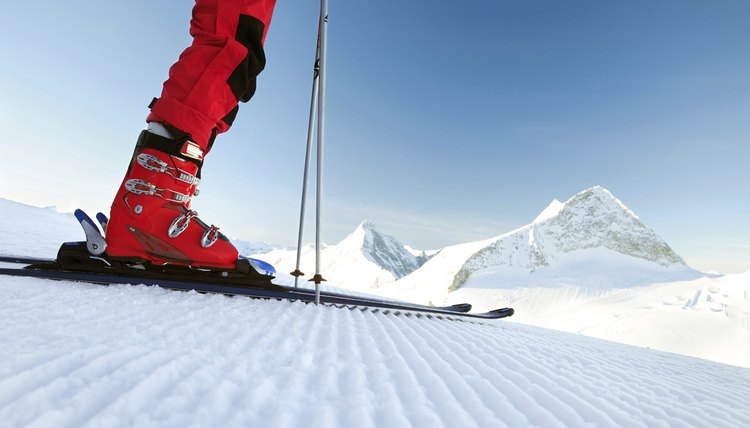What does fact checked mean?
At SportsRec, we strive to deliver objective content that is accurate and up-to-date. Our team periodically reviews articles in order to ensure content quality. The sources cited below consist of evidence from peer-reviewed journals, prominent medical organizations, academic associations, and government data.
The information contained on this site is for informational purposes only, and should not be used as a substitute for the advice of a professional health care provider. Please check with the appropriate physician regarding health questions and concerns. Although we strive to deliver accurate and up-to-date information, no guarantee to that effect is made.
Sore Calves From Ski Boots

The calf pain associated with stiff ski boots is enough to make you consider snowboarding. Fortunately, the pain-killing endorphins produced while soaring downhill at exhilarating speeds usually override the pain. But if the skier's high fails to produce the desired results, you can look into several possible reasons for your boot-related calf pain.
Use the Right Setting
There's a good chance that the culprit causing your ski-boot-related calf pain does not rear its ugly head while you are on the slopes. Instead, walking though the base area causes the "ouch factor." Your ski boots have an often-ignored ski/walk lever. Most manufacturers place this lever in the back of the boot cuff. In the walk setting, your boot freely hinges forward or rearward. The ski setting, which is much stiffer than the walk setting, locks the boot into the forward-lean position. This affects your movement mechanics and potentially causes calf pain.
Dehydration-Related Calf Pain
The high alpine locations of many ski resorts produce excellent snow conditions, but the thin, dry air may cause dehydration and potassium depletion. Both of these conditions may induce chronic or acute calf pain, according to the sports rehab specialists at the website SportsInjuryClinic. Avoiding the dehydrating affects of alcoholic drinks and drinking extra glasses of water may solve the problem. Eating potassium-rich foods such as bananas and baked potatoes also can help.
Check the Sheets
Ski-boot-related calf pain rarely results from one isolated cause. In most cases, a conspiracy of perpetrators gang up on your circulatory system and wreak havoc on your lower leg muscles. One possible suspect is your bed sheets. Some people like their sheets and blankets firmly tucked into the bed. This presses your feet down, tightening your lower leg muscles. While it's possible to get away with this at home, on a ski vacation this bed-sheet setup can add to the circulatory problems resulting from altitude, dehydration and stiff ski boots.
Boot Fit and Technique
Ski boot fit and improper ski technique also can cause calf pain. Boots that fit too high or too low on the calf, as well as boots that are either too tight or too loose for your calf size, are potential culprits. Wearing extra heavy socks or wearing multiple pairs of socks distorts your boot fit and ski technique. The back-seat position, a common problem amongst novices, shifts your weight to the tail of the ski, thereby hyper-extending your legs and locking your calf muscles. The chronic state of muscular tension exacerbates calf pain. An expert ski boot fitter, combined with a certified ski instructor's discerning eye, can help you find the solution to your sore calf problem. If possible, find an instructor who works in conjunction with a local boot fitter.
References
Writer Bio
In 1999, Lisa Mercer’s fitness, travel and skiing expertise inspired a writing career. Her books include "Open Your Heart with Winter Fitness" and "101 Women's Fitness Tips." Her articles have appeared in "Aspen Magazine," "HerSports," "32 Degrees," "Pregnancy Magazine" and "Wired." Mercer has a Bachelor of Arts in psychology from the City College of New York.
